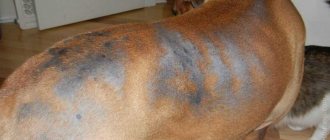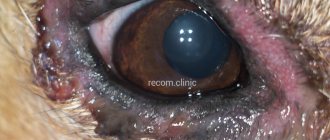Full range of cardiological examinations on the day of treatment Planned and emergency cardiological appointments Monitoring of severe cardiac patients in a hospital setting
Dilated cardiomyopathy is a disease characterized by impaired pumping function and contractility of the myocardium. Accompanied by expansion of the chambers of the heart, thinning of the walls of the ventricles of the heart, rhythm disturbances and congestive processes in the body. Dilated cardiomyopathy in dogs is more common among large and giant breeds, predominantly affecting males. It is divided into primary - the etiology has not been fully studied, and secondary, the causes are other pathologies. Dilated cardiomyopathy is much less common in dwarf dog breeds; they are more likely to suffer from valvular defects.
For the convenience of our visitors, appointments are available for scheduled cardiology appointments. You can ask all questions by calling our numbers - +7 (495) 9473033, +7 (495) 9471408
Causes of DCM in dogs
The causes of primary dilated cardiomyopathy are not fully understood; deficiency of taurine and L-carnitine presumably plays a role in the development of the process. The genetic cause of the pathology in boxers and some other breeds has been proven.
Causes of secondary dilated cardiomyopathy:
- Myocarditis.
- Coronary circulatory disorders.
- Pathologies of the valve apparatus.
- Severe metabolic disorders.
- Infectious diseases.
- Systemic inflammatory processes.
- Poisoning.
- Overdoses and side effects of toxic drugs.
Signs of dilated cardiomyopathy
The main clinical symptoms of DCM in the early stages of the disease are:
- fast fatiguability,
- dyspnea.
At later stages of pathology development:
- cough appears;
- weight loss;
- shortness of breath progresses (signs of congestion in the lungs appear).
The terminal stage is characterized by right ventricular failure with the development of ascites.
Attacks of acute heart failure in DCM
DCM is characterized by periodic attacks of acute heart failure, which can lead to sudden death of the animal. They are accompanied by:
- sudden development of general weakness, up to loss of consciousness with convulsive syndrome (syncope),
- rapid breathing,
- pallor or cyanosis of the mucous membranes.
The cause of these attacks is usually severe arrhythmias , which complicate the course of DCM. Arrhythmias arise due to damage to the normal structure of the heart muscle, which creates favorable conditions for disruption of the processes of generation and conduction of electrical impulses and excitation of muscle fibers. With DCM, various forms of ventricular arrhythmias often develop, including life-threatening ventricular tachycardia, up to ventricular fibrillation. In addition, more than half of dogs with DCM develop atrial fibrillation.
Symptoms of DCM in dogs
Often the initial stages of the disease are asymptomatic; their development continues for months and sometimes years. In such cases, DCM is diagnosed mainly by chance during cardiac ultrasound. Clinical signs of the disease can develop either slowly or over a short period of time. Sudden death, which is not preceded by any symptoms, often occurs.
Characteristic signs of DCM:
- Shortness of breath and increased fatigue after minor physical exertion or stress.
- Drowsiness.
- Cough.
- Paleness of the mucous membranes.
- Weight loss with a simultaneous increase in the volume of the abdominal cavity (abdominal edema).
- Attacks of severe weakness, up to loss of consciousness.
- Periodic convulsive seizures.
- In severe cases, gurgling breathing develops with pulmonary edema.
A preliminary diagnosis is made on the basis of a physical examination; to clarify it, the following is carried out:
- Chest X-ray.
- ECG.
- Ultrasound (echocardiography) of the heart.
For a timely diagnosis, owners of large and giant breed dogs should contact a veterinarian at the first signs of DCM - weakness, fatigue and shortness of breath.
How to diagnose the disease?
The primary diagnosis is made based on a general examination of the pet and the owner’s complaints. The doctor examines:
- Mouth. The mucous membranes are pale or bluish in color, and the capillary refill rate is longer than normal.
- Measures heart rate, femoral artery heart rate is weakened.
- There may be a pulse deficit (if arrhythmia has already developed).
- Listens to breathing; in the presence of wheezing and shortness of breath, it is important to exclude pulmonary edema and respiratory diseases.
- Palpates the abdomen for fluid accumulation.
To confirm the diagnosis, the following studies are performed:
- Ultrasound. Determines the presence of pathologies in the structure of the organ.
- Chest X-ray. Shows how the shadows of the heart, atrium, and trachea change (in some cases).
- ECHO KG. Shows changes in ventricular size, mitral valve insufficiency. In the later stages, arrhythmia, high pressure in the pulmonary artery, and an increase in atrium volume are visible.
- EGC. The intervals between contractions indicate the presence of disturbances in the heart rhythm.
Note that all signs of the development of the disease are not necessary. Some of them arise only at a late stage. In Doberman pinschers and boxers, no changes in the structure of the myocardium and ventricles are observed for 2-3 years. In them, DCM manifests itself only in the form of arrhythmia.
Dilated cardiomyopathy in dogs treatment
If a latent form of DCM is detected, the animal is prescribed antihypertensive drugs (most often ACE blockers), beta blockers, diuretics, antiarrhythmic drugs (in the presence of tachyarrhythmias).
If acute heart failure develops against the background of DCM, emergency therapy includes:
- Intravenous administration of furosemide.
- Use of nitroglycerin ointment or spray or sodium nitroprusside infusion.
- Inotropic support (digoxin, dopamine).
- Keeping the animal in an oxygen chamber.
- Use of sedatives in cases of severe anxiety.
- If there is fluid in the pleural cavity, thoracentesis is performed and the effusion is pumped out.
The introduction of new drugs and changes in dosage should be carried out carefully, with constant monitoring, as the condition can worsen very quickly.
Long-term therapy includes oral administration:
- Furosemide (in combination with potassium supplements) or veroshpirone.
- ACE inhibitors (captopril, enalapril). They should be used with caution in combination with potassium supplements, as there is a risk of developing hyperkalemia.
- Vetmedin or digoxin - prescribed for supraventricular tachyarrhythmias and atrial fibrillation.
- Preparations with a high content of L-carnitine, taurine, omega 3 fatty acids.
- Beta blockers - metoprolol, carvedilol.
The medication continues for life, with constant monitoring of the condition and dosage. At the beginning of treatment, examinations are carried out 2-3 times a week, after stabilization of the condition and selection of effective doses - once every 2-3 months. You should reduce the salt content in the diet and strictly dose physical activity, and avoid exposing your dog to stress factors.
Surgical treatment has been developed - installation of elastic support structures that improve myocardial contractility and prolong its functional activity.
Symptoms and diagnosis of the disease
The danger of any disturbances in the functioning of the heart muscle lies in its hidden course in the early stages. Manifestations of dystrophic changes occur in advanced cases, when serious interventions by a veterinarian cannot be avoided.
Symptoms of cardiomyopathies occur in the later stages due to changes that provoke myocardial failure. Adaptation mechanisms fail. The first symptoms of transformations in the functioning of the pump for pumping blood throughout the body are breathing problems. A sick dog develops shortness of breath, often accompanied by a rare and quiet cough. Congestion occurs in the pulmonary structures, manifested by characteristic wheezing when breathing. The owner of the animal does not immediately understand that the cough and depression are caused not by a cold, but by disorders in the myocardium.
A few weeks after the appearance of the first symptoms - shortness of breath, cough, depression, wheezing when breathing, ascites or hydrothorax develops. The pet's activity decreases, the dog lies down more, and signs of cardiac cachexia appear. It happens that heart failure progresses rapidly, characterized by the development of edema in the lungs, shortness of breath and severe weakness. The prognosis for the development of acute heart failure is cautious, often unfavorable. Complications accompanying CMP include loss of consciousness and fainting for a long time.
The appearance of characteristic signs of the development of disturbances in the functioning of the body against the background of cardiomyopathies requires immediate contact with a veterinary clinic for help. The veterinarian must conduct a general clinical examination and anamnesis. It is important to understand when the changes began, which will allow you to make the most accurate diagnosis.
A mandatory diagnostic test for suspected cardiomyopathy is echocardiography. Suspecting that genetic mutations are the cause of the development of dystrophic changes in the heart muscle, special testing is carried out. Such animals are not allowed to reproduce in the future and are culled.
In addition to echocardiographic examination, radiography and ultrasound examination of organs located in the chest cavity are performed. A general blood test and a biochemical panel are prescribed to assess the state of neglect of the pathological process throughout the body.
Forecast
Depending on the stage of the disease and the general condition of the animal, the prognosis ranges from cautious to unfavorable. For symptoms of pulmonary congestion, life expectancy depends on the initial response to treatment. In its absence, dogs rarely live more than 3-4 months. If the initial response to treatment is good, the animal can live 6-12 months or more. If a diagnosis is made at an early stage and adequate therapy is prescribed, life expectancy increases to 3-4 years or more.
In our clinic, detection of cardiac diseases is carried out by veterinary doctors - cardiologists who have extensive experience working with dogs and cats. Our veterinary clinic is also equipped with all the necessary equipment for examining cardiac patients.
Cardiological examination and appointment are conducted by doctors Lidiya Mikhailovna Biryukova and Olga Vladimirovna Evstifeeva.
You can make an appointment with them by calling the clinic numbers.
Canine DCM
All owners of large dog breeds need to know about this predisposition in order to recognize alarming symptoms in time in order to begin treatment for this dangerous disease as early as possible, thereby significantly improving the pet’s quality of life and prognosis.
What is this disease characterized by? Why is she so dangerous? Cardiomyopathies are diseases in which the heart muscle is primarily affected (without signs of inflammation). Dilated cardiomyopathy (DCM) is characterized by enlargement (dilatation), usually of all four chambers, and a decrease in the pumping function of the heart (systolic failure). Male and middle-aged animals are more susceptible to this disease.
Often, DCM can be long-lasting and asymptomatic, and clinical signs may appear at the end stage of heart failure, but sometimes the clinical history can be short, a few days or weeks, with a full range of clinical manifestations. Characteristic signs of the disease are symptoms such as lethargy of the animal, decreased resistance to physical exertion, shortness of breath and cough, weight loss (cachexia), abdominal enlargement (caused by the accumulation of free fluid in the abdominal cavity - ascites), as well as attacks of loss of consciousness. If more than one of the described symptoms appears in a dog, you should take your pet to a veterinary cardiologist. The principle also works here: the earlier treatment or prevention is started, the better the prognosis. The diagnosis is usually made as a result of a comprehensive study: examination by a specialist, chest x-ray, electrocardiogram, echocardiography and blood pressure measurement.
The prognosis depends on the breed and stage of the disease. Unfortunately, the average survival time for patients with clinical symptoms after diagnosis is still considered to be 6 months. This is associated with the development of arrhythmias such as atrial fibrillation or ventricular extrasystoles, as well as as a result of the development of continuous, treatment-resistant congestive heart failure. Representatives of the Doberman Pinscher breed have the least favorable prognosis in this sense; we can say that the disease in these patients occurs in a more aggressive form. There is also a risk of sudden death, especially in Dobermans and Boxers, as a result of ventricular arrhythmia. But in general, many dogs can demonstrate positive treatment results with adequate therapy, with an average survival time of 1-2 years.
Treatment of DCM is symptomatic or supportive: it reduces or prevents the development of congestive heart failure, improves systolic heart function, and prevents the development of arrhythmias. There are also types of additional therapy that are especially effective in the early asymptomatic stages of the disease, such as the introduction of substances such as L-carnitine, taurine, and omega-3 into the diet. At the moment, there is an opinion that the isolated use of such substances can significantly slow down the development of this pathology in those animals that have a tendency to develop DCM. Therefore, it is so important to conduct a cardiac examination in adult young dogs of large breeds that do not yet have symptoms, once a year, for the purpose of medical examination. In such cases, a cardiac examination is carried out according to an abbreviated program, the so-called screening tests (ECHO + ECG).
All types of these studies, the prescription of correct therapy, and the management of such patients are carried out in our clinic by cardiologists.
Diagnosis of hidden cardiomyopathy
Obvious signs of CHF indicate the final stage of the disease, which is difficult to treat, so the life expectancy of the sick animal begins to count in months, and maybe even weeks. Obviously, early diagnosis is most important for proper treatment. Studying a combined, long-term (24-hour), outpatient electrocardiogram (Holter monitoring) and echocardiogram allows us to identify a sick dog much earlier than it develops clinical symptoms. Therefore, Doberman owners are recommended to have their healthy dogs examined annually due to their predisposition to this disease.
Holter Monitoring Holter monitoring is a valuable diagnostic test for detecting occult CM, especially when this test is complemented by echocardiography. The presence and frequency of VT can be determined with an accuracy of 80-90% if this record is obtained and analyzed using modern computer technology.
The number of premature ventricular contractions (PVCs) that may be considered abnormal for Doberman Pinschers has not yet been determined. Although several PVCs are quite normal, they may accompany the very first signs of CM. The rate of healthy Doberman Pinschers with normal electrocardiograms whose 24-hour Holter recordings contain multiple PVCs is approximately 20% among dogs under 4 years of age and 50-70% among dogs over 4 years of age. More than 100 PVCs in a 24-hour period should be considered abnormal, especially in the presence of paired, triplet, runaway, or ventricular tachycardia (VT). If CM is not detected at the earliest stage, most affected Dobermans will exhibit at least several hundred, if not thousands, of PVCs over a 24-hour period.
Echocardiography An echocardiogram is a valuable diagnostic test, especially when accompanied by a Holter recording. Moderate and severe deviations are fairly easy to identify, but confident identification of the earliest deviations is much more difficult. Absolutely normal values for this breed of dog are difficult to establish due to the widespread prevalence of occult CM and the reliance on linear assessment of overall left ventricular function. For Doberman Pinschers, the normal left ventricular internal dimensions (LVID), taken from the right parasternal-sagittal plane, are less than 46 mm in diastole (LVID) and less than 39 mm in systole. A left ventricular shortening fraction (LVF), which is greater than or equal to 30%, is considered normal, while the authors consider a figure of 26-29% doubtful. The E-point of septal separation (EPSS) is not sensitive to early dysfunction and should be less than 9 mm. Normal or equivocal echocardiographic results combined with high-quality 24-hour monitoring contain over 100 PVCs, indicating early stage CM, unless there is another fairly obvious cause of PVCs. Any PVCs observed during an ultrasound examination are associated with CM, although their absence does not exclude the presence of this disease. Progression of myocardial failure is best demonstrated by serial LVHR, EPSS, and left atrial measurements rather than by FU studies.
Static electrocardiography An electrocardiogram is not able to detect the early stages of CM. However, any PVC recorded on a 6-minute electrocardiographic rhythm strip raises strong suspicions about the presence of this disease, although, as mentioned above, the absence of PVC does not exclude it. The frequency of occurrence or absence of PVCs on short electrocardiographic strips cannot be used to identify the risk of sudden death. Prolongation of P waves (> 0.04 sec) and QRS complex (> 0.06 sec) occur only in the advanced stage of CM and indicate that CHF is already present or will occur without proper treatment within the next 6-9 months.
X-ray examination X-ray does not reveal mild or moderate enlargement of the left side of the heart. Enlargement of the left atrium is associated with the progressive stage of CM, and therefore, if left untreated, CHF will occur within the next year.
The role of diagnostic treatment in the differential diagnosis of cardiomyopathies in dogs and cats
Ex juvantibus therapy
carried out to clarify the diagnosis, if it is not contraindicated by the somatic condition of the sick animal. The principle of therapy for dogs and cats with cardiomyopathies is to correct heart failure, improve symptoms and survival. In dogs and cats with cardiomyopathies, a combination of ACE inhibitors, β-blockers, diuretics, antiarrhythmic and metabolic agents has a good therapeutic effect, which quite often makes it possible to clarify the diagnosis based on positive dynamics during therapy. It should be noted that the therapeutic effect is observed within 2-3 weeks from the start of treatment. Clinical studies of recent decades have established the high therapeutic effectiveness of pimobendan for cardiomyopathies in dogs and cats. Pimobendan (for the treatment of dogs and cats with cardiomyopathies complicated by chronic heart failure of any functional class.
Thus, using an integrated approach, it is possible to make a final diagnosis in dogs and cats with cardiomyopathies.
^Top
Laboratory diagnostics and differential diagnosis for cardiomyopathies in dogs and cats
Biochemical methods for studying blood serum in sick dogs and cats can detect an increase in the level of enzymes and substrates contained in cardiomyocytes (LDH1, LDH2, CPK-MB, cardiac troponin, myoglobin), as well as atrial and brain natriuretic peptides. According to our research, in the majority of dogs with DCM, the activity of aspartic transaminase (AST) in the blood serum increases. It should also be noted that the AST level positively correlates with the functional class of chronic cardiovascular failure (R = 0.35; P










